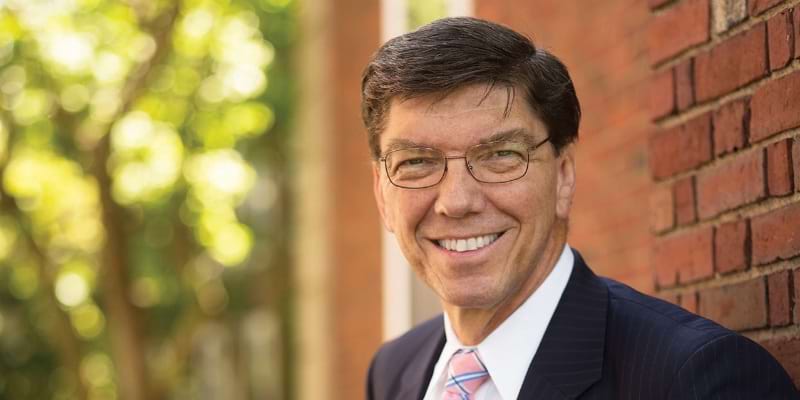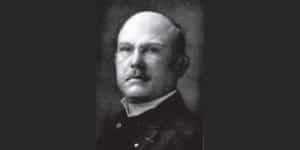Clayton Christensen biography and books

Clayton Christensen (Clayton Magleby Christensen, April 6, 1952 – January 23, 2020) was a well-known American scientist and business consultant. He became best known for his theory of ‘disruptive innovation’. Clayton Christensen co-founded Rose Park Advisors, a venture capital firm, and Innosight, a leading innovation consultancy. Christensen’s ideas have had a profound impact on the business world and continue to inspire change.
Biography Clayton Christensen
Clayton Christensen was born in Salt Lake City, Utah. He was the second of eight children of Robert M. Christensen and Verda Mae Christensen.
Youth and education
He grew up in the Rose Park neighborhood of Salt Lake City and attended West High School, where he served as student council president. Christensen and his siblings were raised as members of the LDS Church.
An avid basketball player, standing 6 feet 8 inches (2.03 m) tall, he played as a starting center on the University of Oxford men’s team. After graduating from high school in 1970, Christensen was accepted to Harvard University, Yale University, and Brigham Young University (BYU).
After prolonged prayer and a clear sense of inspiration, he chose to attend BYU, where he had received a full scholarship. At BYU, he studied economics and attended classes with future US presidential candidate Mitt Romney and future Dean of Harvard Business School, Kim B. Clark.
In 1971, Christensen left on a mission trip for the LDS Church to South Korea for two years as a full-time volunteer. He learned to speak Korean fluently and returned to BYU to resume his studies. In 1975, he received his Bachelor of Arts degree with highest honors in economics.
After graduating, he received a Rhodes Scholarship and spent two years studying applied econometrics at Queen’s College, University of Oxford, where he received his M.Phil. degree. Back in the United States, Christensen attended Harvard Business School, where he received his MBA magna cum laude in 1979.
He built an impressive academic base and developed his expertise in business innovation and strategy. This early period of his life laid the foundation for his later career as an influential academic and consultant in the field of innovation and disruptive technologies.
Career and entrepreneurship
After completing his doctoral research, Christensen joined the Harvard Business School faculty in 1992 and rose to the position of professor in six years.
He became famous for his teaching style and research in business strategy and innovation.
In 2000, Christensen founded Innosight LLC, a consulting and training company specializing in guiding companies through disruptive innovation. Three years later, he co-founded Ceramics Process Systems Corporation (now CPS Technologies), a company that produces advanced ceramics. He also served as president and CEO of CPS Technologies in the late 1980s before deciding to pursue an academic career.
Christensen’s influence extended beyond teaching and consulting. He co-founded Innosight Ventures, a venture capital firm focused on investments in Asia, and Rose Park Advisors LLC, an investment firm that applied his research as an investment strategy.
Throughout his career, Christensen has served on the boards of Tata Consultancy Services, Franklin Covey and the Becket Fund for Religious Liberty.
A prolific author, he authored ten books, including his seminal work “The Innovator’s Dilemma”, which received the Global Business Book Award. The concept of disruptive innovation, explored in this book, was widely recognized and influential in the business world.
Christensen also wrote about specific industries and addressed social issues such as education and healthcare in books such as “Disrupting Class” and “The Innovator’s Prescription”. He received critical acclaim and numerous awards for this.
In 2017, Christensen made a remarkable prediction that attracted a lot of attention. He predicted that within the next 10 to 15 years, about 50 percent of colleges and universities in the United States would face financial challenges leading to bankruptcy.
Throughout his career, Clayton Christensen has made significant contributions as a professor, researcher, consultant and author. His ideas and theories continue to shape the field of business and innovation and have a lasting impact on how organizations adapt and thrive in a rapidly changing world.
Personal life of Clayton Christensen
Christensen married his wife Christine in 1976. They had three sons together: Matthew, Michael and Spencer, and two daughters, Ann and Catherine. Their eldest son, Matthew Christensen was a member of the Duke University basketball team.
A member of the LDS Church, Christensen served as a missionary in Korea from 1971 to 1973, where he became fluent in Korean. He held several leadership positions in the LDS Church, including that of bishop. His book “The Power of Everyday Missionaries” was an important work within the LDS Church on how all people can be involved in sharing the gospel, regardless of their position in the church.
He was also a driving force behind the creation of Kristen Smith Dayley’s book “For All The Saints,” about the history of the LDS Church in New England, which was published in 2012 and for which Christensen wrote the foreword.
Christensen was diagnosed with follicular lymphoma in February 2010 and suffered a stroke in July 2010 that damaged his speech and required speech therapy. In 2011, Christensen published two more books: “The Innovative University” and “The Innovator’s DNA”.
On January 23, 2020, Christensen died at the age of 67 from leukemia. This is his personal website.
Famous quotes
- “It’s easier to hold your principles 100 percent of the time than it is to hold them 98 percent of the time.”
- “Motivation is the catalyzing ingredient for every successful innovation. The same is true for learning.”
- “Because if the decisions you make about where you invest your blood, sweat, and tears are not consistent with the person you aspire to be, you’ll never become that person.”
- “Culture is a way of working together toward common goals that have been followed so frequently and so successfully that people don’t even think about trying to do things another way. If a culture has formed, people will autonomously do what they need to do to be successful.”
- “Decide what you stand for. And then stand for it all the time.”
- “Disruptive technologies typically enable new markets to emerge.”
- “Disruptive technology should be framed as a marketing challenge, not a technological one.”
- “First, disruptive products are simpler and cheaper; they generally promise lower margins, not greater profits. Second, disruptive technologies typically are first commercialized in emerging or insignificant markets. And third, leading firms’ most profitable customers generally don’t want, and indeed initially can’t use, products based on disruptive technologies.”
- “I don’t view it as mystic. I believe that God is our father. He created us. He is powerful because he knows everything. Therefore everything I learn that is true makes me more like my father in heaven. When science seems to contradict religion, then one, the other, or both are wrong, or incomplete. Truth is not incompatible with itself. When I benefit from science it’s actually not correct for me to say it resulted from science and not from God. They work in concert.”
- “I had thought the destination was what was important, but it turned out it was the journey.”
- “I used to think that if you cared for other people, you need to study sociology or something like it. But….I [have] concluded, if you want to help other people, be a manager. If done well, management is among the most noble of professions. You are in a position where you have eight or ten hours every day from every person who works for you. You have the opportunity to frame each person’s work so that, at the end of every day, your employees will go home feeling like Diana felt on her good day: living a life filled with motivators.”
- “If you defer investing your time and energy until you see that you need to, chances are it will already be too late.”
- “In contrast, investing time and energy in your relationship with your spouse and children typically doesn’t offer that same immediate sense of achievement. Kids misbehave every day. It’s really not until 20 years down the road that you can put your hands on your hips and say, ‘I raised a good son or a good daughter.’ You can neglect your relationship with your spouse, and on a day-to-day basis, it doesn’t seem as if things are deteriorating. People who are driven to excel have this unconscious propensity to underinvest in their families and overinvest in their careers—even though intimate and loving relationships with their families are the most powerful and enduring source of happiness.”
- “In fact, how you allocate your own resources can make your life turn out to be exactly as you hope or very different from what you intend.”
- “In order to really find happiness, you need to continue looking for opportunities that you believe are meaningful, in which you will be able to learn new things, to succeed, and be given more and more responsibility to shoulder.”
- “In our lives and in our careers, whether we are aware of it or not, we are constantly navigating a path by deciding between our deliberate strategies and the unanticipated alternatives that emerge.”
- “In your life, there are going to be constant demands for your time and attention. How are you going to decide which of those demands gets resources? The trap many people fall into is to allocate their time to whoever screams loudest, and their talent to whatever offers them the fastest reward. That’s a dangerous way to build a strategy.”
- “Indeed, while experiences and information can be good teachers, there are many times in life where we simply cannot afford to learn on the job. You don’t want to have to go through multiple marriages to learn how to be a good spouse. Or wait until your last child has grown to master parenthood. This is why theory can be so valuable: it can explain.”
- “Intimate, loving, and enduring relationships with our family and close friends will be among the sources of the deepest joy in our lives.”
- “Justification for infidelity and dishonesty in all their manifestations lies in the marginal cost economics of ‘just this once.”
- “People don’t want to buy a quarter-inch drill. They want a quarter-inch hole.”
- “Resisting the temptation whose logic was ‘In this extenuating circumstance, just this once, it’s OK’ has proven to be one of the most important decisions of my life. Why? My life has been one unending stream of extenuating circumstances. Had I crossed the line that one time, I would have done it over and over in the years that followed.”
- “Resources are what he uses to do it, processes are how he does it, and priorities are why he does it.”
- “The hot water that softens a carrot will harden an egg.”
- “The only metrics that will truly matter to my life are the individuals whom I have been able to help, one by one, to become better people.”
- “The only way to be truly satisfied is to do what you believe is great work. And the only way to do great work is to love what you do. If you haven’t found it yet, keep looking. Don’t settle. As with all matters of the heart, you’ll know when you find it.”
- “The reason is that good management itself was the root cause. Managers played the game the way it was supposed to be played. The very decision-making and resource-allocation processes that are key to the success of established companies are the very processes that reject disruptive technologies: listening carefully to customers; tracking competitors’ actions carefully; and investing resources to design and build higher-performance, higher-quality products that will yield greater profit. These are the reasons why great firms stumbled or failed when confronted with disruptive technological change.”
- “There are more than 9,000 billing codes for individual procedures and units of care. But there is not a single billing code for patient adherence or improvement, or for helping patients stay well.”
- “You can talk all you want about having a clear purpose and strategy for your life, but ultimately this means nothing if you are not investing the resources you have in a way that is consistent with your strategy. In the end, a strategy is nothing but good intentions unless it’s effectively implemented.”
- “The lesson I learned from this is that it’s easier to hold to your principles 100% of the time than it is to hold to them 98% of the time. If you give in to ‘just this once,’ based on a marginal cost analysis, as some of my former classmates have done, you’ll regret where you end up. You’ve got to define for yourself what you stand for and draw the line in a safe place.”
Books and publications by Clayton Christensen et al.
- 1992. Exploring the limits of the technology S‐curve. Part I: component technologies. Production and operations management, 1(4), 334-357.
- 1995. Disruptive technologies: catching the wave. Harvard business review, 73(1), 43-53.
- 1995. Explaining the attacker’s advantage: Technological paradigms, organizational dynamics, and the value network. Research policy, 24(2), 233-257.
- 1996. Customer power, strategic investment, and the failure of leading firms. Strategic management journal, 17(3), 197-218.
- 1998. Strategies for survival in fast-changing industries. Management science, 44(12-part-2), S207-S220.
- 2000. Meeting the challenge of disruptive change. Harvard business review, 78(2), 66-77.
- 2000. Will disruptive innovations cure health care?. Harvard business review, 78(5), 102-112.
- 2001. Competitive advantage. MIT sloan management review, 42(2), 105-109.
- 2001. Making friends with disruptive technology:‐an interview with Clayton M. Christensen. Strategy & Leadership, 29(2), 10-15.
- 2002. The great leap: Driving innovation from the base of the pyramid. MIT Sloan management review, 44(1), 51.
- 2004. Seeing what’s next: Using the theories of innovation to predict industry change. Harvard Business Press.
- 2006. Disruptive innovation for social change. Harvard business review, 84(12), 94.
- 2006. The ongoing process of building a theory of disruption. Journal of Product innovation management, 23(1), 39-55.
- 2008. Disruptive innovation in health care delivery: a framework for business-model innovation. Health affairs, 27(5), 1329-1335.
- 2008. Reinventing your business model. Harvard business review, 86(12), 50-59.
- 2008. Strategic management of technology and innovation. McGraw-Hill/Irwin.
- 2009. Disrupting Class: Disruptive Innovation Will Change the Way the World Learns. Education Review.
- 2009. The innovator’s prescription: a disruptive solution for health care. New York: McGraw-Hill.
- 2011. Managing disruption: an interview with Clayton Christensen. Research-Technology Management, 54(1), 11-17.
- 2011. The innovative university: Changing the DNA of higher education from the inside out. John Wiley & Sons.
- 2013. Is K-12 Blended Learning Disruptive? An Introduction to the Theory of Hybrids. Clayton Christensen Institute for Disruptive Innovation.
- 2013. Disruptive innovation. Brighton, MA, USA: Harvard Business Review.
- 2013. The innovator’s dilemma: when new technologies cause great firms to fail. Harvard Business Review Press.
- 2013. The innovator’s solution: Creating and sustaining successful growth. Harvard Business Review Press.
- 2016. The Innovator’s Dilemma: When New Technologies Cause Great Firms to Fail. Boston, Mass.: Harvard Business School Press.
- 2016. The Clayton M. Christensen reader. Harvard Business Review Press.
- 2018. Disruptive innovation: An intellectual history and directions for future research. Journal of management studies, 55(7), 1043-1078.
- 2019. The Innovator’s DNA, Updated, with a New Preface: Mastering the Five Skills of Disruptive Innovators. Harvard Business Press.
How to cite this article:
Janse, B. (2023). Clayton Christensen. Retrieved [insert date] from Toolshero: https://www.toolshero.com/toolsheroes/clayton-christensen/
Original publication date: 08/03/2023 | Last update: 08/03/2023
Add a link to this page on your website:
<a href=”https://www.toolshero.com/toolsheroes/clayton-christensen/”> Toolshero: Clayton Christensen</a>











